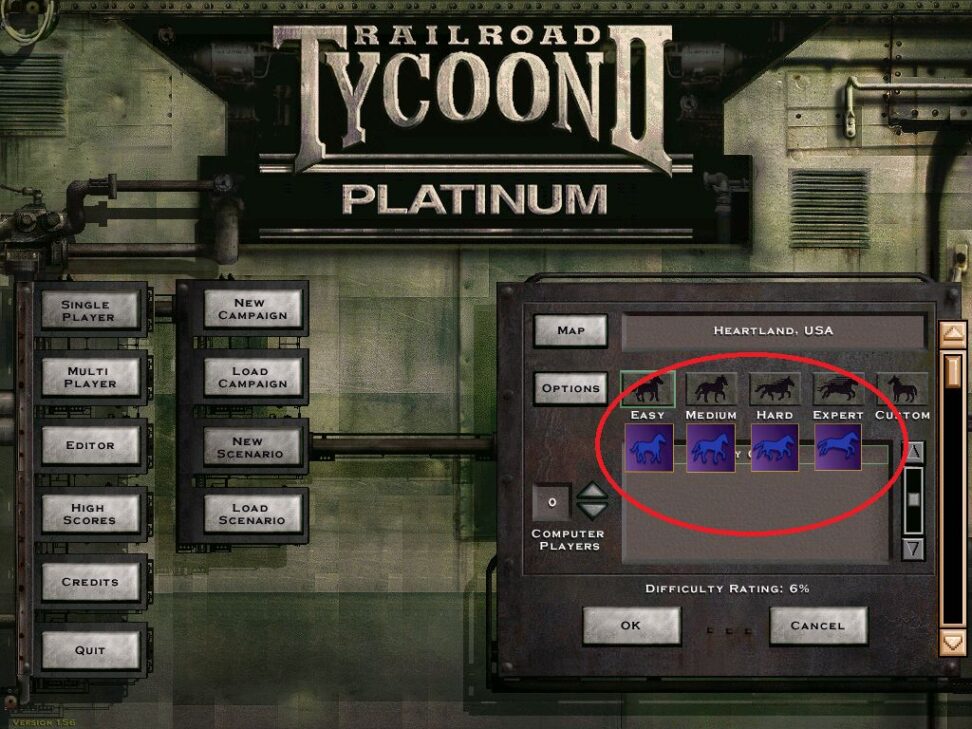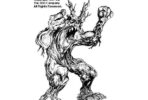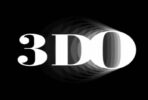Heroes 3.5: In the Wake of Gods Portal > HoMM3 Recollection: Phil Steinmeyer and Railroad Tycoon 2
HoMM3 Recollection: Phil Steinmeyer and Railroad Tycoon 2

If you are reading Fanstratics newsletter carefully, you already know about this information, and if not, you should definitely subscribe to the news here.
For this particular story, there is a fair amount of hearsay. As I did not have first-hand knowledge of many events and details, take it all with a grain of salt.
When I started work as New World Computing (NWC), there was one specific name occasionally mentioned in begrudging whispers… Phil. I had no idea who was attached to the name ‘Phil’, but scattershot information implied he had worked on Heroes of Might and Magic 2 (HoMM2). I didn’t give ‘Phil’ too much thought, because… he was no longer working at… or with… NWC. Phil had no bearing or influence on Heroes of Might and Magic 3 (HoMM3), so I simply ignored the subject.
I believe it was in April 1998, when I was sitting in Jon Van Caneghem’s (JVC) office. At this stage in HoMM3’s development, JVC and I had gotten into a comfortable ‘developmental’ rhythm. Over the course of a week, I would hash out design details. When JVC came into the office, about 2 or 3 days a week, I would get together with him (assuming Paul Rattner didn’t need him for something), and we’d go over what I put together. Jon would give each item a thumbs up or down, and if he didn’t like anything, we’d try to work it out right there in his office. We were about start a session, typically taking 3 to 4 hours, when George Ruof poked his head into the room.
He addressed JVC, “Did you see they announced Railroad Tycoon 2 (RT2). Gathering of Developers is publishing.”
JVC chuckled, “I’ll guess I’ll try it when it comes out.”
George looked at me and said, “You know, you might see Phil at E3 next month.”
I shrugged, as Phil was still something of a mystery to me, and replied, “Uh… yeah. It’s possible.”
After George had moved on, I turned to JVC and asked, “Railroad Tycoon?”
JVC, “Didn’t I tell you about that?”
Me, “No.”
JVC, “It was something Phil and I had discussed.”
Me, “I know Phil worked on Heroes2. You, Mark, Paul, and George, have mentioned his name, but I really have no idea who he is.”
JVC nodded his head, as he understood what I was asking, “Phil Steinmeyer was the main programmer on Heroes1 and Heroes2. He offered up ideas, just like Debbie did, so I gave him a design credit. After he left, he told anyone who would listen, ‘he’ was the reason Heroes was a success.”

Phil Steinmeyer and Railroad Tycoon 2
The facts? According to MobyGames, Phil was the Lead Programmer on HoMM1 and HoMM2. Phil also has a Design credit on HoMM1 (along with JVC’s wife Debbie Van Caneghem), and HoMM2 (along with Debbie and Paul Rattner).
Obviously, there had been a falling out between JVC and Phil, and while I don’t know why Phil stopped working with NWC, it was clear JVC didn’t appreciate Phil taking credit for the success of HoMM1 and HoMM2.
Me, “What does this have to do with Railroad Tycoon?”
JVC, “When we were developing Heroes2, Phil and I had chatted about Railroad Tycoon. We both loved it, and wondered why there had never been a sequel. So, we talked about NWC acquiring the rights, or making its own version. After Phil left, I heard rumors he was making his own Railroad Tycoon… and now we know.”
A quick month later, I was in Atlanta, Georgia. In 1998, from May 28th to May 30th, E3 was held at the Georgia World Congress Center. Of all the people on the HoMM3 team, I was the logical choice to demo the game, so I joined the flight from California, with Mark Caldwell, Scott McDaniel (marketing), Ben Bendt (Vegas Games), and Keith Francart (Might and Magic).
At E3, I had a kiosk where I demonstrated HoMM3, from 10am to 5pm. When I left my stool, it was only for about 30 minutes, to grab a couple hot dogs and a soda pop (well after lunch). On the last day of the show, early in morning, before people began visiting the ‘3DO room’, I was milling about and approached Mark Caldwell and Scott McDaniel.
Scott, “How have the presentations been going?”
I shrugged, “Good, I guess. It’s hard for me to tell.”
Mark jumped in, “It’s been good. He rarely gets a break.”
I stared at Mark and raised my eyebrows, “I could use some help. I haven’t seen the floor yet.”
Mark put out his hands and laughed, “Hey, just let us know. We’ll take over for an hour or two.”
Scott, “It looks like you have a steady stream of people, and a lot of watchers.”
Mark turned to Scott, “Phil was here. He watched him give a demo.”
Scott seemed to relish the thought, “Oh, Really.”
Me, “When?”
Mark, “Yesterday.”
Scott turned to me, puzzled, “You didn’t see him?”
Mark replied to Scott, “He’s never met Phil.”
Scott slyly replied, “Ohhhh.”
At this moment, I spotted someone hovering around the HoMM3 kiosk. I still had unanswered questions, but I also had a job to do.
Me, “Gotta go.”
Scott called to me as I left, “Let us know when you need a break.”
I never finished my conversation with Mark and Scott, and to my surprise, the last day of E3 was just as busy as the first. When it came time for me to get some food, I waved to Mark and Scott, and pointed to the kiosk.
Me, “I’m taking two hours. I’m going to walk the floor.”
Mark and Scott, drinks in hand, walked on over.
Scott, “Don’t worry, we got it. Take your time.”
So, I left the 3DO room, bought some food, and began exploring.
In 1998, at the Georgia World Congress Center, the main hall for the show was in Building B, where the secondary hall was in Building A. From the beginning, E3 was created to highlight video game consoles. In the main hall you would find Nintendo, Sega, Sony, and all the ‘large’ publishers (Activision, EA, Ubisoft, etc.). In the secondary hall, you would find all the businesses who couldn’t afford a spot in the main hall. This included small publishers, small hardware developers, retailers, etc. Basically, anyone attempting to maintain a presence, or get a foot in the door, of the very competitive video game industry. It wasn’t uncommon for the secondary floor to be called the ‘E3 slum’ or the ‘E3 getto’, and it was here I stumbled across the area occupied by Gathering of Developers.

On two stools, positioned in front of a single kiosk, was a middle-aged man was giving a demo for Railroad Tycoon 2, to an attentive middle-aged woman. I can only assume the man was Phil Steinmeyer.
Every story has two sides, truthful or not, and I was curious to hear Phil’s interpretation of the events leading to his eventual departure from NWC. Watching Phil demo his game, I loitered for a little bit. I wanted to introduce myself, but it was clear Phil had just started giving his presentation, and I needed to get back to the 3DO room.
At this specific moment, watching Phil do his work, I decided what happened between Phil and NWC was really none of my business. It didn’t involve me, it didn’t affect me, and it had no bearing on my job or my life. So, I walked away. A part of me thought this would be the last I ever saw or heard of Phil Steinmeyer… but it wasn’t.
My memory is fuzzy concerning the details, but if I recall correctly, Gathering of Developers released Railroad Tycoon 2, in early November, along with a demo. At NWC, a handful of people were quick to download and play the demo, one of them being George Ruof.
George poked his head into my office, “Did you see the demo for Railroad Tycoon 2 is available?
Me, “Oh. Okay.”
George, “You might want to check it out. I’m downloading it right now.”
Setting aside my work, I downloaded Railroad Tycoon 2, and installed it on my computer. I couldn’t tell you what I was expecting, but one thing was apparent… on this particular subject… I needed to be ‘in the loop’.
Upon starting the game, almost immediately, the demo gave me an ‘unsettled’ feeling. After roughly 30 minutes, George saw me tinkering with the demo, and stopped by my office again.
George, “Does it feel familiar?”
Me, “Yeah. It kinda does. The scroll bars and these horse icons remind me of Heroes2.”
George, “That’s because it is. I decompiled the executable and found Heroes2 references in the code.”
George quickly alerted Mark, who subsequently notified 3DO. Within a week, 3DO filed a lawsuit against PopTop Software and Gathering of Developers, for unlawfully using the HoMM2 engine to develop RT2. After some legal wrangling, the judge ordered both NWC and PopTop to produce printouts of the complete source code for HoMM2 and RT2. In the end, it was clear Phil had used the HoMM2 source code to make RT2. In his defense, he asserted JVC had told him he could freely use HoMM2’s game engine. JVC found this claim laughable.
Ultimately, Take Two Interactive, who had a stake in Gathering of Developers, asked 3DO what they wanted to make the lawsuit go away. 3DO asked for 1 million USD… and there it ended.
With HoMM3 well into development, and the lawsuit resolved, never again did I hear anyone ever utter the name ‘Phil’. As for RT2, it sold more than 1.5 million copies. With Phil being both the designer and programmer of the game, and the owner of PopTop (later sold to Take Two), I suspect he did quite well for himself, and was able to walk away from the industry on his own terms. According to MobyGames, his last game credit was in 2006.





